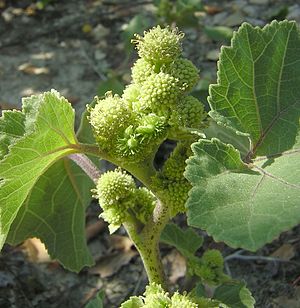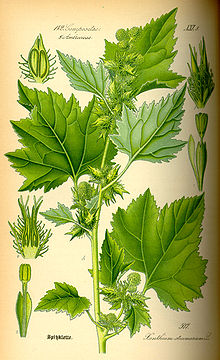Ordinary pointed burdock
| Ordinary pointed burdock | ||||||||||||
|---|---|---|---|---|---|---|---|---|---|---|---|---|

Above male, below female inflorescences and leaves of the common pointed burdock ( Xanthium strumarium ) |
||||||||||||
| Systematics | ||||||||||||
|
||||||||||||
| Scientific name | ||||||||||||
| Xanthium strumarium | ||||||||||||
| L. |
The cocklebur ( Xanthium strumarium ) is a plant from the genus of cocklebur ( Xanthium ) in the subfamily of Asteroideae within the family of Compositae (Asteraceae).
description

Xanthium strumarium usually grows as an annual , herbaceous plant that usually reaches heights of 10 to 80 (rarely up to 200) cm. The upright stems are branched and have no thorns at the nodes . The mostly alternate (two to six can also be opposite) leaves are stalked 2 to 10 (rarely up to 14) cm long. The almost circular, five-, triangular, heart-shaped and three- to five-lobed leaf blade has a length of mostly 4 to 12 (rarely to over 18) cm and a width of 3 to 10 (rarely to over 18) cm. The leaf margin is smooth to toothed.
Xanthium strumarium is monoecious, monoecious . The disc-shaped, small, cup-shaped inflorescences are rarely found individually, mostly in branched overall inflorescences . The flower heads contain only flowers of one sex. The male flower heads are flattened plate-shaped, have a diameter of 3 to 5 mm, contain six to 16 bracts in one to two rows and 20 to over 50 functionally male flowers with whitish, funnel-shaped, five-lobed corollas . The stamens are fused. The female flower heads have a diameter of 2 to more than 5 mm during the flowering period; later than fruit baskets they have a diameter of 6 to over 20 mm. Their 30 to over 75 bracts are in six to over twelve rows; their tips are more or less curved and form hard thorns as the fruit ripens. The female flower heads contain only two flowers without petals. The flowering period extends from July to October.
The black achenes have no pappus and are distributed in the thorny, two-chambered, 1 to over 3 cm large fruit baskets (in this case the diaspores ), the "burdock". They use the burdock effect by getting caught on the fur of animals passing by or on floating debris and thus spreading them out.
The number of chromosomes is 2n = 36.
ecology
The common pointed burdock is therophyte , an annual, summer annual plant that roots up to 1.2 meters deep. It also endures a certain amount of salt in the soil.
It is a short day plant d. H. the flowers only form when there is less than 16 hours of daylight. Just a single short day is enough to induce the flowering process. The common pointed burdock is monoecious, sexually separated d. H. male and female flowers are in separate heads on the same plant specimen. The male heads are many-flowered and have a stunted style. The female heads are only two-flowered. In terms of flower ecology, it is wind flowering of the "immobile type".
The fruits spread as Velcro fruits , in addition there is a water spread with alluvial sand. The seeds have 40% fatty oil and are heat germs. Fruit ripening is from October to November.
Distribution and location
Like all Xanthium species, Xanthium strumarium is native to the New World . It is a neophyte in much of the world . It thrives in Central Europe in gappy weed corridors, on rubbish spots on paths or dumps on fresh, nutrient-rich, more or less humus-rich, loose, mostly sandy-stony loam soils and is a species of the Sysimbrietalia order. In southern Europe it is a species of the Chenopodion muralis association.
Systematics
Xanthium strumarium was first published by Carl von Linné . The botanical genus name Xanthium is derived from the Greek word xanthos for "yellow"; this name refers to the fact that a yellow dye was extracted from the leaves of Xanthium strumarium .
The systematics of the genus pointed burdock ( xanthium ) has not yet been conclusively clarified. In the common pointed burdock or stinging pointed burdock ( Xanthium strumarium L. , Syn .: Xanthium pungens Wallroth ), several varieties are distinguished:
- Canadian cocklebur or Italian cocklebur, Orient cocklebur, Large fruited cocklebur, sugar-cocklebur ( Xanthium strumarium var. Canadense (Mill.) Torr. & A.Gray , Syn .: Xanthium italicum Moretti , Xanthium orientale L. , Xanthium saccharatum Wallr. )
- Xanthium strumarium var. Glabratum (DC.) Cronquist
- Xanthium strumarium var. Japonicum (Aries) Hara
- Xanthium strumarium L. var. Strumarium .
According to Greuter, W. (2006+), the following subspecies can be distinguished:
- Xanthium strumarium subsp. strumarium
- Xanthium strumarium subsp. brasilicum (Vell.) O. Bolòs & Vigo (Syn .: Xanthium brasilicum Vell. ): It occurs in southern Europe, the Middle East and North Africa.
- Xanthium strumarium subsp. sibiricum (Aries) Greuter (Syn .: Xanthium sibiricum Aries ): It occurs as a neophyte in Russia, Estonia, the Ukraine and in Transcaucasia.
Toxicity
Xanthium strumarium produces the glycoside carboxyatractyloside , which mainly causes the toxicity by inhibiting an important translocator in the mitochondrion. It has a central, bacteriostatic and fungicidal inhibitory effect. The leaves are also said to be harmful to grazing animals. The plant can cause contact dermatitis on the skin . In India, eczema was observed on the hands and feet, which was caused particularly by plants in the pre-crop stage.
use
The green parts of the plant can only be eaten cooked, as they are poisonous raw. The seeds are eaten raw or cooked and are also processed further.
Parts of the plant are used medicinally and are also used in various ways in folk medicine.
Tannin is extracted from the dried leaves . A yellow dye was also obtained from the leaves. The seeds contain essential fatty acids .
swell
- John L. Strother: Xanthium : ( Xanthium strumarium ), p. 19 - online with the same text as the printed work . In: Flora of North America Editorial Committee (Ed.): Flora of North America North of Mexico. Volume 21: Magnoliophyta: Asteridae, part 8: Asteraceae, part 3 (Heliantheae, Eupatorieae) , Oxford University Press, New York and Oxford, 2006, ISBN 0-19-530565-5 .
- Xanthium strumarium at Interactive Agricultural Ecological Atlas of Russia and Neighboring Countries. Economic Plants and their Diseases, Pests and Weeds .
- Ruprecht Düll , Herfried Kutzelnigg : Pocket dictionary of plants in Germany and neighboring countries. The most common Central European species in portrait. 7th, corrected and enlarged edition. Quelle & Meyer, Wiebelsheim 2011, ISBN 978-3-494-01424-1 .
- Lutz Roth, Max Daunderer, Kurt Kormann: Poison Plants - Plant Poisons. Occurrence, effect, therapy, allergic and phototoxic reactions. With a special section about poisonous animals. 6th revised edition, special edition. Nikol, Hamburg 2012, ISBN 978-3-86820-009-6 .
Individual evidence
- ↑ a b c Erich Oberdorfer : Plant-sociological excursion flora for Germany and neighboring areas . With the collaboration of Angelika Schwabe and Theo Müller. 8th, heavily revised and expanded edition. Eugen Ulmer, Stuttgart (Hohenheim) 2001, ISBN 3-8001-3131-5 , pp. 925 .
- ^ Xanthium strumarium at Tropicos.org. In: IPCN Chromosome Reports . Missouri Botanical Garden, St. Louis
- ↑ Xanthium strumarium in the Germplasm Resources Information Network (GRIN), USDA , ARS , National Genetic Resources Program. National Germplasm Resources Laboratory, Beltsville, Maryland.
- ↑ a b c Werner Greuter (2006+): Compositae (pro parte majore). - In: W. Greuter & E. von Raab-Straube (ed.): Compositae. Euro + Med Plantbase - the information resource for Euro-Mediterranean plant diversity. Datasheet Xanthium strumarium In: Euro + Med Plantbase - the information resource for Euro-Mediterranean plant diversity.
- ↑ a b c Xanthium strumarium at Plants For A Future
- ↑ Use in folk medicine - Dr. Duke's Phytochemical and Ethnobotanical Databases . ( Memento of the original from May 11, 2009 in the Internet Archive ) Info: The archive link was inserted automatically and has not yet been checked. Please check the original and archive link according to the instructions and then remove this notice.
Web links
- Xanthium strumarium L. s. str., common pointed burdock. In: FloraWeb.de.
- Ordinary pointed burdock . In: BiolFlor, the database of biological-ecological characteristics of the flora of Germany.
- Profile and distribution map for Bavaria . In: Botanical Information Hub of Bavaria .
- Xanthium strumarium L. In: Info Flora , the national data and information center for Swiss flora . Retrieved April 25, 2016.
- Thomas Meyer: Spitzklette data sheet with identification key and photos at Flora-de: Flora von Deutschland (old name of the website: Flowers in Swabia )
- Characteristics.
- On the toxicity of Xanthium strumarium : DB Munro: Canadian poisonous plants information system - online.
- photos



